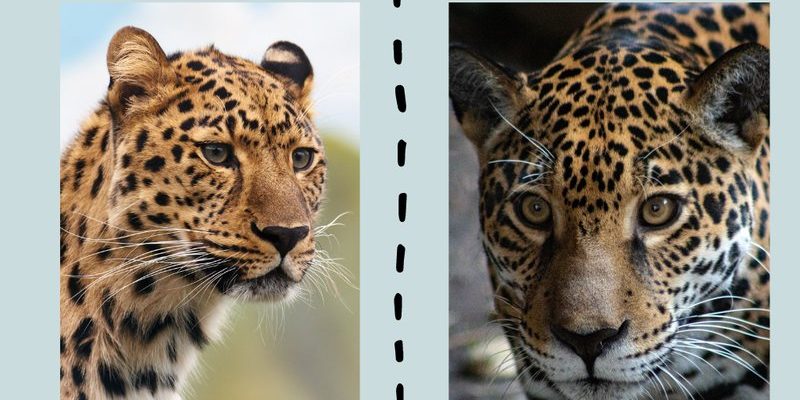![Comparing The Jaguar Vs. [Similar Species]](https://gudri.com/wp-content/uploads/2025/06/Comparing_The_Jaguar_Vs___Similar_Species__image_0.jpg)
Understanding these differences is not just fascinating; it helps us appreciate the diversity of nature. Just like comparing two different flavors of ice cream—both are delicious, but one might suit your taste a little better. So, let’s explore the jaguar and leopard side by side, diving into their habitats, physical traits, behaviors, and more.
Habitat: Where Do They Live?
Jaguars: Masters of the Jungle
Jaguars primarily roam the rainforests of South America, particularly in the Amazon Basin. They thrive in habitats that offer dense vegetation and access to water sources like rivers and lakes. This lush environment provides both cover for stalking prey and plentiful food options, such as capybaras, caimans, and various fish.
Interestingly, they’re also found in more varied terrains like savannas and dry forests. But the crucial element in their habitat is the availability of water—jaguars are known to be excellent swimmers, often hunting in aquatic environments. Imagine a big cat diving into a river, showcasing its agility and power. That’s the jaguar for you!
Leopards: Adaptable Felines
On the other hand, leopards display incredible adaptability when it comes to habitat. You can find them in various regions across Africa and parts of Asia, from savannas to forests and even mountainous regions. This flexibility allows them to thrive in environments that range from grasslands to tropical rainforests.
Leopards prefer areas with plenty of cover because they are stealthy hunters, often relying on trees for camouflage. They have a knack for climbing, allowing them to escape danger or store their prey away from scavengers. Think of leopards as the true urban survivors of the big cat world, able to make a home in diverse surroundings.
Physical Appearance: Spot the Difference
Jaguar: A Robust Build
When it comes to physical appearance, jaguars are robust and muscular cats, with a broad head and powerful jaws. They have a distinctive coat featuring a pattern of rosettes—large, circular spots with a central dot—on a yellow or tan background. This unique pattern is not just for show; it helps them blend into the dappled light of the jungle, making it easier to ambush prey.
Jaguars are also heavier than leopards, weighing between 100 to 250 pounds, with males typically larger than females. They are one of the largest cats in the world, second only to the tiger. Their strength allows them to take down larger prey, even animals as formidable as caimans.
Leopard: Sleek and Graceful
Leopards, on the other hand, are more slender and agile, weighing between 70 to 200 pounds. They have a similar rosette pattern on their coats, but the shapes tend to be closer together and smaller than those of the jaguar. Their fur varies in color, often ranging from golden-yellow to tawny.
One of the leopard’s standout features is its long body and short legs, which contribute to its gracefulness when moving. They are built for speed and stealth, making them exceptional hunters. You might picture a leopard sneaking through tall grass—silent, sharp, and ready to pounce.
Behavior: Hunting Techniques and Social Life
Jaguar: The Silent Hunter
Jaguars are known for their solitary and secretive nature. They tend to be more reclusive than leopards, preferring to hunt alone rather than in groups. Their hunting style is quite unique; they use their powerful bite to pierce through the shells of turtles or the skulls of larger prey.
When hunting, jaguars often lie in wait, using the element of surprise. Once they spot their target, they pounce, leveraging their incredible strength to overpower them in a flash. This calculated approach is key to their success as predators.
Leopard: The Cunning Opportunist
Conversely, leopards are clever and can adapt their hunting strategies depending on the situation. They are known for their ability to stalk their prey and, much like a skilled thief, they often employ ambush tactics. If they can’t immediately overpower an animal, they’ll retreat and wait for the perfect moment.
Leopards are also more social than jaguars. While they hunt alone, they will occasionally share their kills with other leopards if food is scarce. This behavior showcases their adaptability and willingness to survive in a competitive environment.
Conservation: Challenges They Face
Jaguars: Threats in the Wild
Both jaguars and leopards face significant threats in the wild due to habitat loss and poaching. Jaguars are particularly vulnerable, as deforestation in the Amazon is rapidly diminishing their habitat. The increasing encroachment of agriculture and urban development poses serious risks to their survival.
Conservation efforts are crucial to ensure these magnificent cats continue to roam their native lands. Organizations work tirelessly to protect their habitats and create corridors to connect fragmented areas, allowing jaguars to migrate safely and find mates.
Leopards: A Struggle for Survival
Leopards, while also threatened, have been able to adapt to some extent. They often thrive near human settlements, which has offered them some protection. However, they still face dangers from hunting and habitat destruction. Poaching for their beautiful pelts and body parts remains a significant challenge.
Efforts to preserve leopards focus on protecting their habitats and promoting coexistence with local communities. Raising awareness about their importance in the ecosystem is also crucial for their survival.
The Bottom Line: Appreciating Both Big Cats
Both the jaguar and the leopard are amazing in their own right, each showcasing unique traits and behaviors that contribute to the biodiversity of our planet. The jaguar, with its powerful build and water-friendly habits, is a master of the jungle, while the leopard, agile and versatile, conquers diverse habitats with ease.
Understanding their differences and the challenges they face helps us appreciate these beautiful creatures and the need to protect them. So, next time you find yourself thinking about these big cats, remember their stories and the integral roles they play in our world. By caring for their habitats and supporting conservation efforts, we can ensure that future generations continue to marvel at the jaguar and the leopard.

